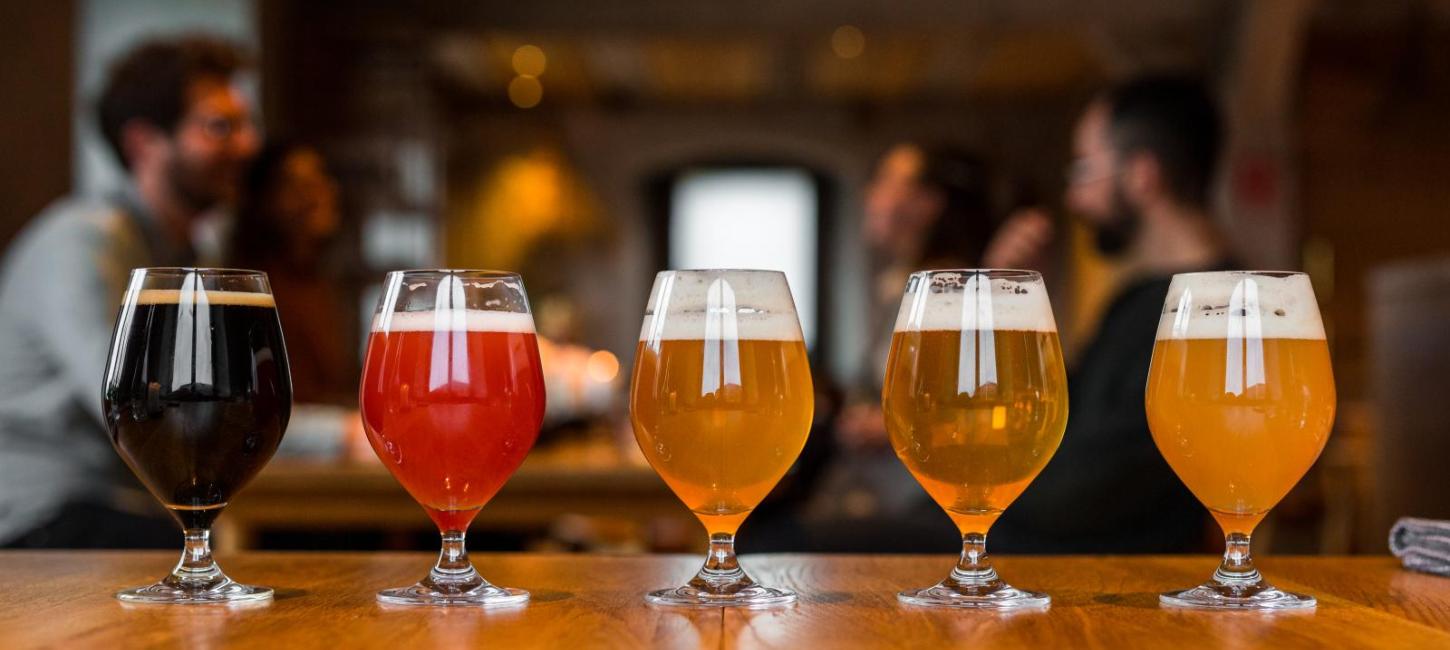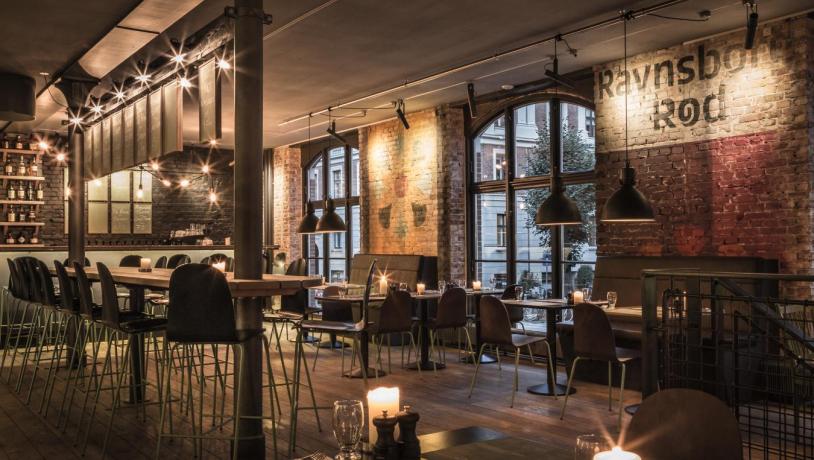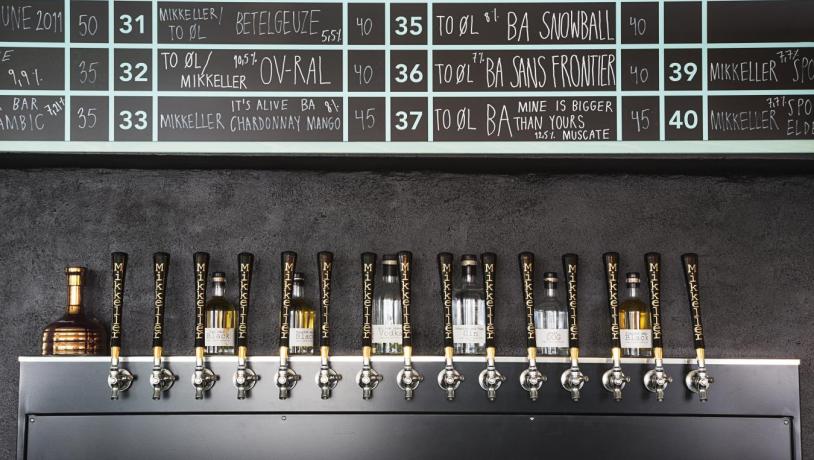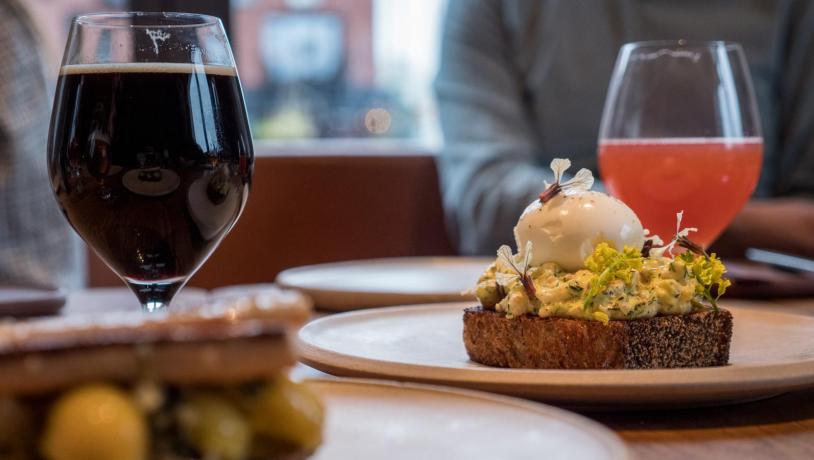Copenhagen: Capital of craft beer
Craft beer is the coolest beverage these years, and there is no better place to discover the variety and quality of craft beer than in Copenhagen.

With 350 different kinds of Christmas beer, one of the world’s best cuisines and a dash of Danish hygge there really is something special brewing in Copenhagen.
Juleøl, Danish for Christmas beer, is of the most beloved drinks amongst Copenhageners when the Christmas atmosphere is in the air, starting from the first Friday in November. Travellers will find Christmas beers everywhere in town – at all the classic Danish dive bars, also known as “bodegas”, as well as at the hip craft beer pubs scattered all over the city.
Darker and stronger than the classic pilsner, Christmas Beer is a unique tradition originating from the Nordic countries which can be traced back to the Viking age. The Vikings, who worshipped the Nordic gods, used to celebrate the dark winter days getting longer and lighter approximately after December 21st, and these celebrations were called “jól” in Old Norse. To celebrate, the Vikings used to drink a dark, strong beer, and the party used to last until there was nothing left to drink. They said that they were “drinking jól”. The same word evolved into the Danish “Jul”, which today actually means “Christmas”, and which explains the origin of the concept of “Juleøl”, Christmas beer.
Todays’ seasonal and festive beers are brewed in many different versions yet save countless history and traditions. The Christmas brews as we know them, largely stem from the 17th-century Bavarian monasteries, where local monks developed an extra-strong and nutritious double buck brewed for Lent, during which they weren’t allowed to eat meat, and a full and nutritious beer was thus essential.
Fast forward to the 20th century, and the strong, dark beer becomes popular in Denmark once again. Initially as a festive brew at Easter (in 1905 the world-famous Danish brewery Carlsberg launched their first-ever Easter brew). Then came the first Danish commercial Christmas brew introduced in Funen in the late ‘50s. Both were chestnut coloured and richly malty bock beers with a hint of liquorice, and it was - and still is - an easy-drinking pleasure, albeit a bit strong.
Today’s unofficial king of Danish Christmas beers, the Tuborg Julebryg, was launched in the early ’80s along with an iconic marketing campaign, that most Danes know by heart, even today. Christmas beer quickly became a common concept in the Danish household and helped fuel the interest in brewing and drinking Christmas beer across the country even further.
In the early ’00s, Copenhagen experienced a craft beer revolution, which turned the beer market upside down, also when it comes to Christmas beers. Local and innovative breweries with a focus on high-quality craft beers popped up everywhere and today, practically all of them let the jingle bells ring for one type of Christmas brew or another.
The passion for drinking jól in Denmark has thus survived for centuries, and today no other city in the world has more cosy and cool beer bars and restaurants dedicated to the art of celebrating the festive season with a toast of Christmas beer, than Copenhagen.
Today, more than 220 Danish breweries produce a world record number of Christmas beers with around 350 varieties – and the Copenhagen breweries are in a fine Christmas mood too, of course. The quality, quantity, and variety of Christmas beers are greater than ever before and nowadays includes both non-alcoholic, light, and bitter beer styles too.
This year alone, new Christmas treats are launched from the Copenhagen breweries Slowburn Brewing, Gamma Brewing, To Øl, Mikkeller and Flying Couch – and all beers taste very different. From an easy and sour beer from Flying Couch to a heavy, pitch-black imperial stout from Gamma Brewing.
The rustic and malt-based dark bock beer is still the most common type of Christmas beer among the breweries in general, but today at the local bars, restaurants, and bottle shops it is possible to find a richness of beer styles from the many inventive Copenhagen breweries. Do make a note, however, on the alcohol percentages of the different Christmas beers, as they vary considerably.
The sweet and bitter India Pale Ale (IPA) with exotic fruit flavours, for instance, is now a common and wonderful addition to the Danish Tradition of Christmas beers. It is a result of the Danish beer revolution and the long-lasting fetish for hops by beer enthusiasts and brewmasters alike.
The most popular Christmas brew of the ‘beer revolutionaries’ is probably Golden Naked Christmas Ale from Jacobsen (7.5 % alcohol), whilst another hugely popular ‘revolutionary’ Christmas beer is Stjernebryg from Herslev Bryghus (9.5 %).
As a new feature to the enormous range of varieties of Christmas beers, you will find non-alcoholic beers, that is. The well-known Mikkeller brewery was a first mover within this field, but other breweries, like To Øl, have joined the trend as well.
To quench your thirst, perhaps skip by BrewPub, the only existing brewery in Copenhagen’s historic city centre, busy, but cosy and with a fine restaurant too, where the dishes are often made with beer too. It is a favourite watering hole for beer lovers of nearly 20 years. Opt for e.g., an Skt. Anna – a Belgian dubbel. 5.5 % ABV or Schlager – a dark lager. 5.6 % ABV.
Alternatively, visit Nørrebro Bryghus, a true pioneer at the Copenhagen beer scene and popular amongst locals and visitors alike due to its high-quality beers and inventive take on the same subject. Ask for e.g., a Jule IPA – IPA. % 6.3 % ABV or a Julebryg – dark ale. 7.0 % ABV.

Photo:Nørrebro Bryghus
As Christmas in Copenhagen and beer are so strongly interconnected, it comes as no surprise, that the local Copenhageners - and anyone else who would like to join them - celebrate the arrival of the festive season every year with two significant Christmas beer events:
The first Friday in November - J-dag* - is affectionately nicknamed national beer day and is a notice of the begging of the festive season. It was created by Tuborg in the early ‘90s, and on J-dag, staff from Tuborg, dressed in blue Santa Claus costumes, visit local bars across the city offering the favourite Tuborg Julebryg to anyone who wishes to join the celebrations. J-dag is an abbreviation for Christmas Beer Day (Juleøl Dag).
On J-dag, when the Danes say, “snow is falling”, it means that you will experience J-dag all over the city as most pubs will be releasing this year’s Christmas beer at 20:59. If you would like to follow the 2021’s Christmas beer celebration route, it is available on the official event’s page at this link.
ØJ-dag is, in fact, on the day before the J-dag, i.e., the first Thursday in November. ØJ-dag is the celebration of Christmas craft beers by beer enthusiasts. The instigator to this event was Ølbaren in the hip local Nørrebro District, which in the early ‘00s of the Danish beer revolution grabbed the opportunity to showcase the huge variety of Danish Christmas craft beers, whilst simultaneously creating a fun alternative to Tuborg’s well-established J-dag. The ‘Ø‘ in ØJ stands for beer enthusiasts (in Danish: Ølentusiaster).
Ølbaren and Taphouse take pride in displaying the broadest and finest selection of Danish Christmas beers. And the craft beer bar at Taphouse only serves Christmas beer on all 61 taps on November 4th (ØJ-dag).
Naturally, the capital of craft beer and the internationally acclaimed Copenhagen gastro scene has a very good grip on the Christmas traditional foods, the Christmas lunches - and the Christmas beers that come with it too.
The Danish Christmas lunch (julefrokost) for one, is a hugely popular phenomenon, perfected by many talented local Chefs and is a pivotal part of the Danish Christmas culture. It is considered the essence of having a hyggelig (cosy) time and is where family, friends, and/or colleagues gather to catch up and celebrate the festive season. The lunches involve an overwhelming amount of delicate local dishes - and are accompanied by beer (and snaps, a spiced brandy made of potatoes).
Typically held from late November to late December, the Danish Christmas lunches include a mixture of seasonal open-faced sandwiches (smørrebrød) and warm dishes. It could be salty dishes like roasted pork, smoked salmon, marinated herring, pan-fried flounder with remoulade, shrimps as well as potatoes, rye bread, pickled red cabbage, liver pâté, and much more that calls for a cold beer to accompany it.
So, if in Copenhagen during the months of November or December do not cheat yourself from a typical Copenhagen Christmas lunch – it is a ‘must try’ for beer afficionados too! Here’s to a jolly good time during the festive season in Copenhagen. The city is about so much more than Christmas beer, of course, but that’s another story - and one which you can read much more about on visitcopenhagen.com.
SKÅL - and welcome to Copenhagen’s charming Christmas celebrations!

Photo:Camilla Stephan
Below is a list of the breweries taking part in the ØJ-dag. Consider this list a good reference point if you would like to try Danish Christmas-craft beers in Copenhagen and experience the festive surroundings revolving around it.
Amager
Blue Raven - Drogdensgade 22, 2300 Amager
Café Langebro - Islands Brygge 1, 2300 Amager
Vinøs Vinbar - Lergravsvej 30, 2300 Amager
Nørrebro
Nørrebro Bryghus - Ryesgade 3, 2200 Copenhagen N
Ølbaren - Elmegade 2, 2200 Copenhagen N
Vesterbro
Dia'legd - Viktoriagade 1, 1655 Copenhagen V
Jernbanecafeen - Reventlowsgade 16, 1651 Copenhagen V
Østerbro
Bicycle Brewing - Ålborggade 20, 2100 Copenhagen Ø
Tap10 - Østerbrogade 122, 2100 Copenhagen Ø
Nordvest
Tribeca / Beer & Pizza Lab - Bygmestervej 2, 2400 Copenhagen NV
Frederiksberg
Bartof Cafe - Ndr. Fasanvej 46, 2000 Frederiksberg
Tap 21 Craft Beer - H. C. Ørsteds Vej 21, 1879 Frederiksberg
Skänk Frederiksberg - Godthåbsvej 26, 2000 Frederiksberg
City Centre
Black Swan - Borgergade 93, 1300 Copenhagen city centre
Brewpub - Vestergade 29, 1456 Copenhagen city centre
Café Globen - Turesensgade 2B, 1368 Copenhagen city centre
Godt Øl - Knabrostræde 25 kld., 1210 Copenhagen city centre
Lord Nelson - Hyskenstræde 9, 1207 Copenhagen city centre
Seaside - Nordre Toldbod 24, 1259 Copenhagen city centre
Skaal København - Kultorvet 11, 1175 Copenhagen city centre
Taphouse - Lavendelstræde 15, 1462 Copenhagen city centre
Trykbar - Møntergade 24, 1116 Copenhagen city centre
Ørsted Ølbar - Nørre Farimagsgade 13, 1364 Copenhagen city centre
Greater Copenhagen
Skum - Svingelport 1, 3000 Helsingør
Skänk Hillerød - Torvet 7, 3400 Hillerød
Richters Ølstue - Vestergade 16, 4600 Køge
Gustav Wieds - Hersegade 11, 4000 Roskilde
Herslev Bryghus - Kattingevej 16, 4000 Roskilde
Klosterkælderen - Store Gråbrødrestræde 23, 4000 Roskilde
Skänk Roskilde - Hestetorvet 10, 4000 Roskilde
Here is a selection of authentic Copenhagen venues serving local Christmas lunches and Christmas beer to go. However, consider booking a table in advance as no Copenhagener likes to miss an opportunity to have a Christmas lunch and one or two Christmas beers too.
Restaurant Barr - Strandgade 93, 1401 Copenhagen city centre
Selma - Rømersgade 20, 1362 Copenhagen city centre
Carl Nielsen - Toldbodgade 5, 1253 Copenhagen city centre
Cafe Sorgenfri - Brolæggerstræde 8, 1211 Copenhagen city centre
Christianshavn Færgecafé - Strandgade 50, 1401 Copenhagen city centre
Toldbod Bodega - Esplanaden 4, 1263 Copenhagen city centre
Cafe Petersborg - Bredgade 76, 1260 Copenhagen city centre
Cafe Gammeltorv - Gammeltorv 20, 1457 Copenhagen city centre
Kanal Cafeen - Frederiksholms Kanal 18, 1220 Copenhagen city centre
Sans Souci - Madvigs Allé 15, 1829 Frederiksberg
Meyers i Tårnet - Christiansborg Slotsplads, 1218 Copenhagen city centre
Restaurant Møntergade - Møntergade 19, 1116 Copenhagen city centre
Schönnemann - Hauser Plads 16, 1127 Copenhagen city centre
Aamanns 1921 - Niels Hemmingsens Gade 19-21, 1153 Copenhagen city centre
Aamanns Etablissement - Øster Farimagsgade 12, 2100 Østerbro
Restaurant Amalie - Amaliegade 11, 1256 Copenhagen city centre

Photo:Daniel Rasmussen
Tuborg
Owned by global beer giant Carlsberg and the brand behind the Tuborg Julebryg – a household name for all Danes.
Tuborg Julebryg – a bock beer. 5.6 % ABV.
Jacobsen
The craft beer brand of Carlsberg. Its assortment always presents treats, not the least the IPA varieties. The Golden Naked Christmas Ale is a new classic.
Golden Naked Christmas Ale – a strong, English ale. 7,5 % ABV.
Carlsberg
The 4th biggest brewery in the world. Carlsberg 47, brewed the first time in 1972 for Carlsberg’s 125th anniversary, always impress the taste buds. The brew is sold all year but was originally only made for Christmas.
Carlsberg 47 – a strong succes lager. 7.0 % ABV.
Flying Couch
This new Copenhagen brewery is flying with numerous different beer styles and the two Christmas beers are the best example: A sour beer and a fruity, juicy IPA.
Slush Ice – a sour beer. 6.0% ABV.
Icebreaker – New England IPA. 6.0 % ABV.
Mikkeller
Expect quality and innovation. Mikkeller was i.e. the first Danish brewery to produce a non-alcoholic Christmas beer. IPA is a part of the DNA of the brand. Therefore: IPA and non-alcoholic beer is equal to Christmas beer for Mikkeller.
Santa’s Hoppy Helper – IPA. 6.0 % ABV.
Drink’n The Snow – brown ale. 0.3 % ABV.
Amager Bryghus
World-famous Amager Bryghus not only produce IPA and imperial stouts for an international group of beer lovers but also Christmas beers. Not surprisingly an IPA and barley wine, the super-strong Reindeer Fuel, which each year is made of a different recipe.
Reindeer Fuel – barley wine. 10.0 % ABV.
Winter in Bangalore – IPA. 6.0 % ABV.
Braunstein
The pride of Køge harbour, south of Copenhagen. The organic BB Julebryg is the perfect all-round beer for Christmas lunches.
BB Julebryg – an amber lager. 5.6 % ABV.
Slowburn Brewing
A quick success for the new Slowburn Brewing known for their range of pilsners and IPA’s. The doppelbock is a new and welcoming addition to the tradition of brewing bock beer at Christmas.
Hibernator Doppelbock – double bock. 7.2 % ABV.
Gamma Brewing
The beer juice masters of Denmark. Stouts and IPAs are also in good hands at Gamma. Expect a bombing of your taste buds.
Jubilee Imperial Stout – imperial stout. 9.0 % ABV.
Crimus IPA – IPA. 6.0 % ABV.
Bryggeriet Skands
Skands brews popular beers of high quality. Easy to enjoy and often you just need another round of these easy-drinking pleasures.
Skands Julebryg – dark ale. 6.5 % ABV.
To Øl
The strongest Danish Christmas beer is Jule Malt from To Øl. It is very creamy and tasty, and you can’t detect the high amount of alcohol. – so, take care.
Jule Malt – milk stout. 15.0 % ABV.
45 Days of Winter – succes lager. 5.0 % ABV.
Spybrew
Santa’s Frosty Nuts was an instant success when launched two years ago. The small brewery in a suburb of Copenhagen can’t go undercover anymore. Inventive and fine beers from Spybrew.
Santa’s Frosty Nuts – a dark, winter warmer. 6.5 % ABV.
Bryggeriet Krenkerup
Some of the most dependable beers in Denmark are from Krenkerup, a manor house south of Copenhagen. Their speciality is German-inspired beers, but this Belgian style ale is just as lovable.
Juleøl – a Belgian ale. 6.3 % ABV.
Herslev Bryghus
Situated on a farm west of Copenhagen and brewed by a former farmer, this organic, strong, Belgian brew is on the to-drink list of every beer lover in Denmark.
Stjernebryg – a strong, dark Belgian ale. 9,5 % ABV.
Økologisk Juleøl – a red ale. 6,0 % ABV.
Jacob Löwenlund
Ølbaren
Marco Malcorps
Mikkeller
Jens Ungstrup
Skaal
Peter Sonne
Flying Couch
Jonas Madvig
Taphouse
Carsten Berthelsen
Author
Bjarke Bundgaard
Carlsberg
Copenhagen’s craft beer scene - press photos. The photographers must be credited.

Senior Manager – Press & PR